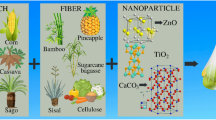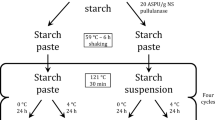Abstract
Degraded gelatin (Gel) and oxidized corn starch (OCS) as abundant, recyclable, and biodegradable materials can be applied to agricultural production, which has been investigated in this research. Firstly, the prepared oxidized corn starch-gelatin (OCS-Gel) composite material was characterized through a Fourier transform infrared spectrometer (FT-IR), a scanning electron microscope (SEM) picture, and a thermogravimetric analysis (TGA). The OCS-Gel was then used as a liquid film mulching for agricultural production, and the application performances (hygroscopicity, permeability, water retention, etc.) of the OCS-Gel were measured. Finally, the planting rapeseed experiments were carried out, and the germination and growing state of the rapeseed seeds were observed. The results from the structural analysis indicated that OCS-Gel enriches pore structure and exhibits high thermal stability up to 324.8 °C. In the application experiments, the OCS-Gel showed excellent properties of water-absorbing and water-retention and low permeability. In addition, the germination rate of the rapeseed seed reached 80 %, and the height of rapeseeds obviously increased in pot experiments after adding the liquid film mulching.








Similar content being viewed by others
References
Ingman, M., Santelmann, M. V., & Tilt, B. (2015). Agriculture water conservation in China: plastic mulch and traditional irrigation. Ecosystems Health Sustainable, 4, 1–11.
Laverde, G. (2003). Agricultural films: types and applications. Journal of Plastic Film & Sheeting, 18, 269–277.
Peng, H., Lei, T., Jiang, Z., & Horton, R. (2016). A method for estimating maximum static rainfall retention in pebble mulches used for soil moisture conservation. Journal of Hydrology, 537, 346–355.
Ma, T. T., Wu, L. H., Chen, L., Zhang, H. B., Teng, Y., & Luo, Y. M. (2015). Phthalate esters contamination in soils and vegetables of plastic film greenhouses of suburb Nanjing, China and the potential human health risk. Environmental Science and Pollution Research, 22, 12018–12028.
Dong, J., Steele-Dunne, S. C., Ochsner, T. E., & van de Giesen, N. (2016). Estimating soil moisture and soil thermal and hydraulic properties by assimilating soil temperature using a particle batch smoother. Advances in Water Resources, 91, 104–116.
Bastos, R. G., Motta, F. L., & Santana, M. H. A. (2014). Oxygen transfer in solid-state cultivation under controlled moisture conditions. Applied Biochemistry and Biotechnology, 2, 708–718.
Cao, L., Wang, W., Yang, L., Yang, C., Yuan, Z., Xiong, S., & Diana, J. (2007). Environment impact of aquaculture and countermeasures to aquaculture pollution in China. Environmental Science and Pollution Research, 14, 452–462.
Coron, L., Pilu, R., Tambone, F., Scaglia, B., & Adani, F. (2015). New energy crop giant cane (Arundo donaxL.) can substitute traditional energy crops increasing biogas yield and reducing costs. Bioresource Technology, 191, 197–204.
Suthar, S. (2007). Nutrient changes and biodynamics of epigeic earthworm Perionyx excavates (Perrier) during recycling of some agriculture wastes. Bioresource Technology, 98, 1608–1614.
Chen, Y., Yang, H., Yang, Q., Hao, H., Zhu, B., & Chen, H. (2014). Torrefaction of agriculture straws and application on biomass pyrolysis poly-generation. Bioresource Technology, 156, 70–77.
Xiong, H. G., Tang, S. W., Tang, H. L., & Zou, P. (2008). The structure and properties of a starch-based biodegradable film. Carbohydrate Polymers, 71, 263–268.
Wesolowska-Trojanowska, M., Tomczynska-Mleko, M., Terpilowski, K., Kawecka-Radomska, M., & Mleko, S. (2016). Ternary biopolymer based on wheat gluten, whey protein concentrate and montmorillonite. Journal of Inorganic and Organometallic Polymers, 3, 555–562.
Varanasi, S., Low, Z. X., & Batchelor, W. (2015). Cellulose nanofibre composite membranes—biodegradable and recyclable UF membranes. Chemical Engineering Journal, 265, 138–146.
Shogren, R. L. (2000). Biodegradable mulches from renewable resources. Journal of Sustainable Agriculture, 16, 33–47.
Kanagaraj, J., Senthilvelan, T., Panda, R. C., & Kavitha, S. (2015). Eco-friendly waste management strategies for greener environment towards sustainable development in leather industry: a comprehensive review. Journal of Cleaner Production, 89, 1–17.
Nur Hanani, Z.A. (2016) Gelatin, reference module in food science, from encyclopedia of food and health. Pages 191–195.
Piccin, J. S., Gomes, C. S., Feris, L. A., & Gutterres, M. (2012). Kinetics and isotherms of leather dye adsorption by tannery solid waste. Chemical Engineering Journal, 83, 30–38.
Ali, U., Sajid, N., Khalid, A., et al. (2015). A review on vermicomposting of organic waste. Environmental Progress & Sustainable, 4, 1050–1062.
Thomazine, T. A., Farayde, M. F., & Silvia, M. M. (2012). Edible films made from blends of manioc starch and gelatin—influence of different types of plasticizer and different levels of macromolecules on their properties. LET—Food Science and Technology, 49, 149–154.
Gómez-Guillén, M. C., Giménez, B., López-Caballero, M. E., & Montero, M. P. (2011). Functional and bioactive properties of collagen and gelatin from alternative sources: a review. Food Hydrocolloids, 25, 1813–1827.
Wang, L., Auty, M. A. E., & Kerry, J. P. (2010). Physical assessment of composite biodegradable films manufactured using whey protein isolate, gelatin and sodium alginate. Journal of Food Engineering, 96, 199–207.
Hernandez-Izquierdo, V. M., & Krochta, J. M. (2008). Thermoplastic processing of proteins for film formation—a review. Journal of Food Science, 73, 30–39.
Martucci, J. F., & Ruseckaite, R. A. (2009). Tensile properties, barrier properties and biodegradation in soil of compression—molded gelatin—dialdehyde starch films. Journal of Applied Polymer Science, 112, 2166–2178.
Matignon, A., Moulin, G., & Barey, P. (2014). Starch carrageenan milk proteins interactions studied using multiple staining and confocal laser scanning microscopy. Carbohydrate Polymers, 99, 345–355.
Nuo, Z. G., Liu, H. S., & Yu, L. (2013). Developing gelatin—starch blends for use as capsule materials. Carbohydrate Polymers, 92, 455–461.
Al-Hassan, A. A., & Norziah, M. H. (2012). Starch—gelatin edible films: water vapor permeability and mechanical properties as affected by plasticizers. Food Hydrocolloids, 26, 108–117.
Du, X. S., Chen, H., & Dai, R. (2012). Preparation and application of denatured starches. Journal of the Society of Leather Technologists and Chemists, 96, 189–194.
Dai, R., Du, X. S., & Shan, Z. H. (2013). Preparation and application of denatured starch-gelatine complex. Journal of the Society of Leather Technologists and Chemists, 97, 256–261.
Dahou, W., Ghemati, D., Oudia, A., & Aliouche, D. (2010). Preparation and biological characterization of cellulose graft copolymers. Biochemical Engineering Journal, 48, 187.
Shirgure, P. S., Sonkar, R. K., & Singh, S. (2003). Effect of different mulches on soil moisture conservation, weed reduction, growth and yield of drip irrigated Nagpur mandarin (Citrus reticulata). Indian Journal of Agricultural Science, 73, 148–152.
Otkin, J. A., Anderson, M. C., Hain, C., Svoboda, M., Johnson, D., Mueller, R., Tadesse, T., Wardlow, B., & Brown, J. (2016). Assessing the evolution of soil moisture and vegetation conditions during the 2012 United States flash drought. Agricultural and Forest Meteorology, 218–219, 230–242.
Ma, Y. J., & Li, X. Y. (2011). Water accumulation in soil by gravel and sand mulches: influence of textural composition and thickness of mulch layers. Journal of Arid Environments, 5, 432–437.
Otalvaro, I. F., Neto, M. P. C., Delage, P., & Caicedo, B. (2016). Relationship between soil structure and water retention properties in a residual compacted soil. Engineering Geology, 205, 73–80.
Acosta, S., Jiménez, A., Cháfer, M., González-Martínez, C., & Chiralt, A. (2015). Physical properties and stability of starch-gelatin based films as affected by the addition of esters of fatty acids. Food Hydrocolloids, 49, 135–143.
Wu, L., Liu, M., & Liang, R. (2008). Preparation and properties of a double-coated slow-release NPK compound fertilizer with superabsorbent and water-retention. Bioresource Technology, 99, 547–554.
Acknowledgments
The authors would like to thank the National Engineering Laboratory for Clean Technology of Leather Manufacture, Sichuan University, (Chengdu, China) for machinery equipment and financial support, and all individuals supported the research work.
Author information
Authors and Affiliations
Corresponding author
Ethics declarations
Conflict of Interest
The authors declare that they have no conflict of interest.
Rights and permissions
About this article
Cite this article
Dang, X., Shan, Z. & Chen, H. The Preparation and Applications of One Biodegradable Liquid Film Mulching by Oxidized Corn Starch-Gelatin Composite. Appl Biochem Biotechnol 180, 917–929 (2016). https://doi.org/10.1007/s12010-016-2142-4
Received:
Accepted:
Published:
Issue Date:
DOI: https://doi.org/10.1007/s12010-016-2142-4




